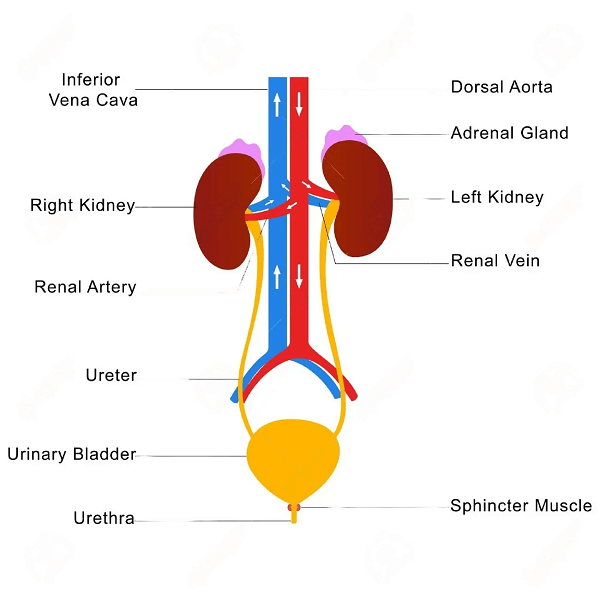Excretion DefinitionBiology defines excretion as the process by which living things eliminate waste or harmful chemicals from their body. It is comparable to removing undesirable chemicals from a living body. Excretory products are the result of the excretion process. 
The production of excretory products can occur during metabolic or nonmetabolic processes. Metabolic activity is useful in promoting excretory function. Excretion occurs via cells in unicellular organisms, whereas it occurs through the body in multicellular species, such as animals and people. Excretory Waste CategoriesLike oxygen in plants and perspiration in people, metabolic wastes are expelled as solids, liquids, and gas. Nonmetabolic wastes are compounds found in living things' bodies that are no longer necessary or of any benefit to them, such as urine and excrement. Excreta of HumansHumans have an excretory system that includes the urinary system. This system consists of the kidneys, ureters, bladder, and urethra. The primary working part of this system is the kidney. A kidney organ called the nephron aids in filtering blood, collecting waste, and keeping it in the kidney. The urine produced by both kidneys serves as a storage space for the waste products from the blood. Urine leaves the kidneys through the ureters and moves to the bladder. The bladder retains urine, but it cannot be held there indefinitely. The urethra receives pressure from the bladder, which causes the urine to flow directly out of our bodies through the urethra. Body parts Enrolled in Human Excretion
1. Kidney The renal pelvis moves urine from the kidney to the ureter; the renal cortex, the kidney's outer layer; and the renal medulla, the kidney's inner layer, make up the kidneys. Characteristics of the kidney During metabolic activity, dangerous waste products, including urea, uric acid, and ammonia, are expelled and end up in our sweat or urine. Keeps our body's homeostasis, which includes the pH balancing of our extracellular fluid and our body's temperature, in control. Additionally, it regulates the quantity of extracellular fluid and aids in keeping its ionic stability. 2. The bladder of the urine The bladder is an organ that resembles a sac and is lined with layers of smooth muscles. The bladder receives urine from the ureters, which stores it until micturition. 3. Urethra A tube called the urethra emerges from the urine bladder. It transports urine from the bladder and serves as the body's method of eliminating waste. 4. Ureter Each kidney is attached to one of the body's two ureters. It is a thin muscular tube whose main job is to transport urine from the kidneys to the bladder so that it may be eliminated. 5. Liver The liver's primary job is to remove waste from the body. Because of this, it serves as the body's first line of defense against hormones, lipids, alcohol, and substances. Additionally, the liver gets rid of extra calories, cholesterol, and certain drugs. The body's health greatly depends on this system. 6. Skin The human body's biggest organ is the skin. While its main job is to shield the body's other organs, they also create moisture to keep the body cool and remove small amounts of extra waste in the forms of salt, urea, and other compounds. 7. Lungs The major organs for respiration are the lungs. They exhale both oxygen and carbon dioxide. Animal ExcretionExcretion usually happens via the diffusion process in animals, whose bodies have a single layer of cells. The excretion occurs through specialized cells in multicellular sponges with a single layer of cells. Waste gases are released into the water and dispersed. Where the external environment of the organism is removed is where it occurs. Excretion occurs through an excessively sophisticated excretory system in more advanced creatures. For instance, the kidney and the urine ducts connected to it are an example of excretory organs where wastes are eliminated in animals. For instance, the food is consumed and then ingested in the case of an elephant. Ingestion is the name for this action. The meal is digested into more easily absorbed elements in the stomach. The assimilation mechanism allows the body to absorb the fluids. After consumption, the product is affected by enzymes, and through metabolism, a chemical reaction happens. Through the excretory system and its organs, the kidneys, and other urine ducts, it causes the body to produce carbon dioxide, which is then expelled to the environment with the help of the lungs in the respiratory system, and oxygen is then taken in. Other waste products, like uric acid, ammonia, etc., are expelled from the body. The human excretory system and this system are sometimes similar. Plant Excretions
We must not overlook that plants can excrete since they are living creatures. The cells of little plants enable them to carry out their excretory function easily. These plants expel wastes onto the cell surfaces. Large plants cannot utilize these cells since they have restricted access to the outside environment. To excrete waste from the extracellular spaces, particularly those in the leaves, they utilize their cells like that of animals. The main consequence of plant excretion is oxygen, or O2, which is essential for human life. Through the large apertures in the leaves called stomata, plants exhale oxygen. It is used during how sunlight works in plants. These stomata intake oxygen and breathe out carbon dioxide, respectively. The primary output of the plant's excretory system is in a gaseous state, in contrast to animals, which is the key distinction between the excretion in plants and animals through extracellular fluid. FAQQ.1. What are the many kinds of waste? Ans: There are two types of waste materials: metabolic and nonmetabolic. The difference between them is whether the elements are created by the chemical reactions of a live cell or carried through an organism's digestive system. Material that is difficult to digest or useless by an organism due to its chemical composition is the principal component of nonmetabolic wastes. These compounds enter a biological system over what the organism requires and can store through absorption, ingestion, or other means. Both digestible and indigestible elements fall within this category. Heat, as well as gases, liquids, and solids, are among the metabolic wastes. Q.2. What do living things excrete in the form of gaseous waste? Ans: Green plants create oxygen during photosynthesis, which is seen as a gaseous waste product that must be eliminated. In a similar vein, carbon dioxide, which is created at night time by both green plants and all animals, is waste. Most invertebrate and vertebrate creatures excrete ammonia, as do microorganisms that cause decay. Some microorganisms release additional nitrogen gas.
Next TopicFamily-Planning Definition
|
 For Videos Join Our Youtube Channel: Join Now
For Videos Join Our Youtube Channel: Join Now
Feedback
- Send your Feedback to [email protected]
Help Others, Please Share









